
Three important messages for the global economy emerged from the latest “World Economic Outlook” released by the International Monetary Fund.
The baseline for economic growth is essentially the same over the medium term, with slightly better shorter-term prospects; the risks are getting bigger and are tilted to the downside; and better national policymaking and improved cross-border coordination can lift prospects.
These messages could well play out this year. It is unlikely, however, that all three will hold true all the way until 2022, the period covered by some of the WEO forecasts.
Instead, the underlying tensions and contradictions associated with protracted low and insufficiently inclusive growth will likely make the macroeconomic situation a lot less stable, thereby materially increasing the likelihood of a tip. The exact nature of this eventual shift, whether to an outcome that is much better or much worse, will depend in large part on whether governments follow up on many of the IMF’s recommendations.
The IMF now forecasts annual average growth for the global economy of about 3.5 per cent in 2017-18, similar to the levels for 2012-15. It will rise to 3.8 per cent in 2022. In terms of components, after reaching 2 per cent in 2017, the advanced economies are projected to grow at just 1.7 per cent in 2022 as three drivers (the Eurozone, Japan and the US) lose some steam. In contrast, the annual growth rate in emerging and developing countries is projected to rise to 5 per cent.
The IMF is essentially projecting a continuation of the “new normal”, after something of a reprieve this year. Specifically, after benefiting from a cyclical bump in 2017 and a spillover from “buoyant financial markets”, advanced economies are again challenged by structural headwinds, including persistent sluggish productivity growth and demographics.
While the rest of the world is expected to improve, this is not sufficient for the much-awaited “lift-off” that the global economy could achieve.
In postulating more of the same over the medium-term, the IMF recognises that risks are “tilted to the downside”.
Noting an inclination toward inward economic orientations, worsening inequality and the risk of policy mistakes — as well as “noneconomic factors, including geopolitical tensions, domestic political discord, risks from weak governance and corruption, extreme weather events, and terrorism and security concerns” -- the IMF is concerned about meaningful slippages.
The most notable of these involves the functioning of the world economy as a result of threats to “global economic integration and the cooperative global economic order that has served the world economy, especially emerging market and developing economies, well.”
While I agree with the IMF’s presentation of the main issues facing the global economy in 2017, I find it increasingly hard to reconcile all three aspects until 2022. Specifically, the medium-term baseline for continued low growth would, in itself, worsen the risks that the IMF correctly identifies.
In the process, the distribution of potential outcomes would likely shift — from the well-behaved, bell-shaped (“normal”) distribution that the IMF postulates to a more bimodal one in which, over time, the probabilities of more extreme scenarios start dominating the belly of the curve.
I examined the details and dynamics of this change in distribution in my recent book, “The Only Game in Town”. And what makes the situation increasingly unstable is that, as the IMF notes, the risks to the new normal baseline “are interconnected and can be mutually reinforcing”.
This is true not only in advanced economies where there are now potentially stronger feedback loops involving economics and politics (Brexit, for example). It is also the case for the (relatively) healthier parts of the global economy: Emerging and developing countries are unlikely to sustain the IMF-projected pickup in growth if advanced countries continue to languish in a low, and increasingly unstable, growth regime.
Fortunately, there is nothing predestined about the way in which the global economy will eventually tip, and this for an important reason that is also specified by the IMF — namely that policy choices will “be crucial in shaping the outlook”. And, for encouragement, policymakers need only look at the extent to which mere announcements have bolstered measures of corporate and household sentiment and confidence.
As the IMF points out, better economic measures at the national level, together with improved policy coordination at the global level, can bolster growth, lower financial risks, counter excessive inequality, and provide a more conducive political context. This requires greater focus on actions to boost potential output, more expansionary fiscal policy where there is room for debt and deficits, and more realistic debt management approaches.
All of these would help unleash more cash into productive activities, as actual economic risk-taking converges up toward financial risk-taking. They would turn strong sentiment measures into improved hard data, and could well be turbocharged by exciting innovations whose influences are spreading economywide from specific companies and sectors.
But if policymaking continues to lag, the new normal will be remembered as the frustrating prelude to a period of unsettling financial instability, recessionary pressures, even greater inequality and more damaging anger politics.
It took too long for conventional wisdom to catch up with the realities of the new normal (or what the IMF belatedly called the “new mediocre”). Now that it has, any analysis needs to be careful not to underestimate the extent to which the already protracted period of low and insufficiently inclusive growth has planted the seeds — economic, financial, institutional, political and social — of its own instability and eventual demise.
— Washington Post












